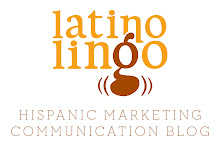New Johnnie Walker responsible drinking campaign
I read with interest a Hispanic PR Wire release from Johnnie Walker about their new responsible drinking campaign. I thought it was a great idea to use Juan Pablo Montoya, the world famous Formula 1 driver from my native land, in their campaign.
The approach, as I can gather from the release, is to have some PSAs with Montoya, point of sale materials, kiosks, a contest and a bi-lingual website.
Cool, I thought, until I checked out the web site they direct you to: www.johnniewalker.com/racing
The first thing you get to is an English language splash page that asks for your country of origin and age. After entering your information in English, you are then directed to the main page that is also in English. You have to click on the Spanish button to get a direct (and at times, very poor) translation of what is essentially general market messaging. I couldn't find the PSA, and the only videos they had were also in English.
This is one of the major gripes I hear about from consumers ... that Hispanic marketing campaigns inevitably lead them to a web site in English. I see this everyday with banks, mortgage companies, healthcare companies, etc. Some are completely in English. Some have a Spanish splash page but all the links lead you to the English website. Some, like this one, offer a direct translation.
I was also a bit surprised that a company of their size wouldn't develop a specific campaign for the Hispanic market and appear to have merely translated what is essentially a general market campaign. In this case, if you follow Formula 1 you know who Montoya is regardless of where you come from anyway.
I don't say all this to bash the campaign, but merely to point out that real resources must be allocated to do something effective and serious. Did they do any research to determine the rate of drunk driving for Hispanics v. non-Hispanics? How about determining how Hispanics and non-Hispanics respond to the same message about responsible drinking? For those who do drive drunk, do the Hispanics ones do it for the same reason as non-Hispanics? Do Hispanics have the same level of understanding about the issue of drunk driving as non-Hispanics (i.e. MADD has existed in the U.S. for decades)? Did they determining if there are any cultural or social differences that should be addressed in the Hispanic market?
Maybe they did do their homework, I don't know since admittedly I'm an outsider here. But, from what I can see in the execution, using translations and directing Latinos to an English language website to spread the general market message seems like a feeble attempt.
The approach, as I can gather from the release, is to have some PSAs with Montoya, point of sale materials, kiosks, a contest and a bi-lingual website.
Cool, I thought, until I checked out the web site they direct you to: www.johnniewalker.com/racing
The first thing you get to is an English language splash page that asks for your country of origin and age. After entering your information in English, you are then directed to the main page that is also in English. You have to click on the Spanish button to get a direct (and at times, very poor) translation of what is essentially general market messaging. I couldn't find the PSA, and the only videos they had were also in English.
This is one of the major gripes I hear about from consumers ... that Hispanic marketing campaigns inevitably lead them to a web site in English. I see this everyday with banks, mortgage companies, healthcare companies, etc. Some are completely in English. Some have a Spanish splash page but all the links lead you to the English website. Some, like this one, offer a direct translation.
I was also a bit surprised that a company of their size wouldn't develop a specific campaign for the Hispanic market and appear to have merely translated what is essentially a general market campaign. In this case, if you follow Formula 1 you know who Montoya is regardless of where you come from anyway.
I don't say all this to bash the campaign, but merely to point out that real resources must be allocated to do something effective and serious. Did they do any research to determine the rate of drunk driving for Hispanics v. non-Hispanics? How about determining how Hispanics and non-Hispanics respond to the same message about responsible drinking? For those who do drive drunk, do the Hispanics ones do it for the same reason as non-Hispanics? Do Hispanics have the same level of understanding about the issue of drunk driving as non-Hispanics (i.e. MADD has existed in the U.S. for decades)? Did they determining if there are any cultural or social differences that should be addressed in the Hispanic market?
Maybe they did do their homework, I don't know since admittedly I'm an outsider here. But, from what I can see in the execution, using translations and directing Latinos to an English language website to spread the general market message seems like a feeble attempt.

